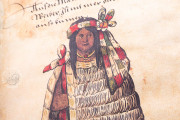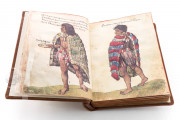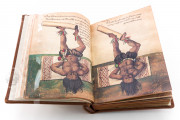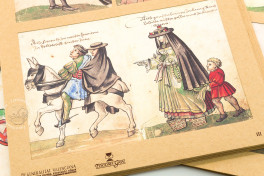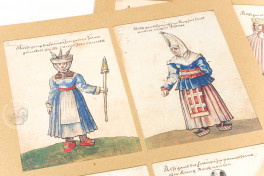The Nuremberg Costume Book is a picture book of the quotidian and ceremonial dress of peoples of the Americas and Europe in the early sixteenth century. Its contents were drawn, colored, and labeled by Christoph Weiditz, an artist at the Hapsburg court in Augsburg in the 1530s. He presumably made sketches for the book during a trip through Europe in the preceding years. Its 154 pages of colored drawings capture the customary dress of various social, religious, and ethnic groups.
The images are painted on one side of the leaves, with most forming pairs across an opening, although the pairs are not necessarily thematically related. The book is paginated, but the blank pages are not numbered, so the number of "pages" equals the number of leaves.
A Traveling Court Artist
Christoph Weiditz (d. 1559) was a painter and medalist working in Strasbourg, Swabia, and Augsburg. In 1529-1532, while traveling on the Iberian and Italian peninsulas and then north to the Low Countries in the retinue of Charles V (1500-1558), Holy Roman Emperor, Weiditz received important commissions and made sketches that would provide the material for his costume book, which he made after his return to Augsburg in 1532.
Gold and Silver Accents
Weiditz executed the book's illustrations in ink applied with a quill. Those drawings are colored in paints both opaque and transparent. The unpainted paper serves as the setting, except for a strip of land in bluish-green that provides a foundation for Weiditz's substantial figures. Occasional details are rendered in gold and silver.
Clothed People in Action
Although known as a "costume" book, Weiditz's manuscript documents much more than dress. Many illustrations show the protagonists engaged in various activities involving animals and ancillary objects. For example, a Castilian cut-purse is shown bare-chested and astride a donkey as he is led through the streets to his punishment (pp. 29-30).
Indigenous Americans
Weiditz had the opportunity to observe the dress and activities of indigenous Mesoamericans brought to Spain by the soldier Hernán Cortés (1485-1547). The thirteen representations of Amerindians in the book are based on observation embellished by European preconceptions about the Indians of Central Mexico. Three scenes show Indian log jugglers, with descriptions of their moves (pp. 6, 8-9), and a scene spread across facing pages depicts two men playing patolli, an ancient American gambling game (pp. 12-13).
Couples
The typical male and female dress of a particular societal group or location may be pictured on facing pages: for example, Portuguese (pp. 14-15), Castilians (pp. 51-52), Basque youths (pp. 131-132), Venetians (pp. 143-144). Female dress often draws the most attention, as in the three views of the dress of Muslim women who had converted to Christianity (pp. 96-98).
Portraits of Contemporary Notables
Weiditz includes a portrait of Hernán Cortés as he appeared in 1529 (p. 77). Also pictured is Andrea Doria (1466-1560), who served Charles V as a naval commander (p. 83).
Engaging Inscriptions
Weiditz wrote the inscriptions in a mannered cursive script with elaborately flourished capital letters. They identify the protagonists and the action and often include commentary. Concerning the indigenous Americans playing patolli, for example, Weiditz writes that "they gamble with their fingers like Italians" (p. 13).
A Resource for Printers
The manuscript's images served as models for other sixteenth-century images in manuscript and print. Of its provenance, we know only that Johann Egger donated it to the Germanisches Nationalmuseum in 1868. The manuscript is preserved in a late eighteenth-century binding.
We have 2 facsimiles of the manuscript "Nuremberg Costume Book":
- Codice de los Trajes Cristobal Weiditz 1529 facsimile edition published by Ediciones Grial, 2001
- Códice de Trajes facsimile edition published by Ediciones Grial, 2001






